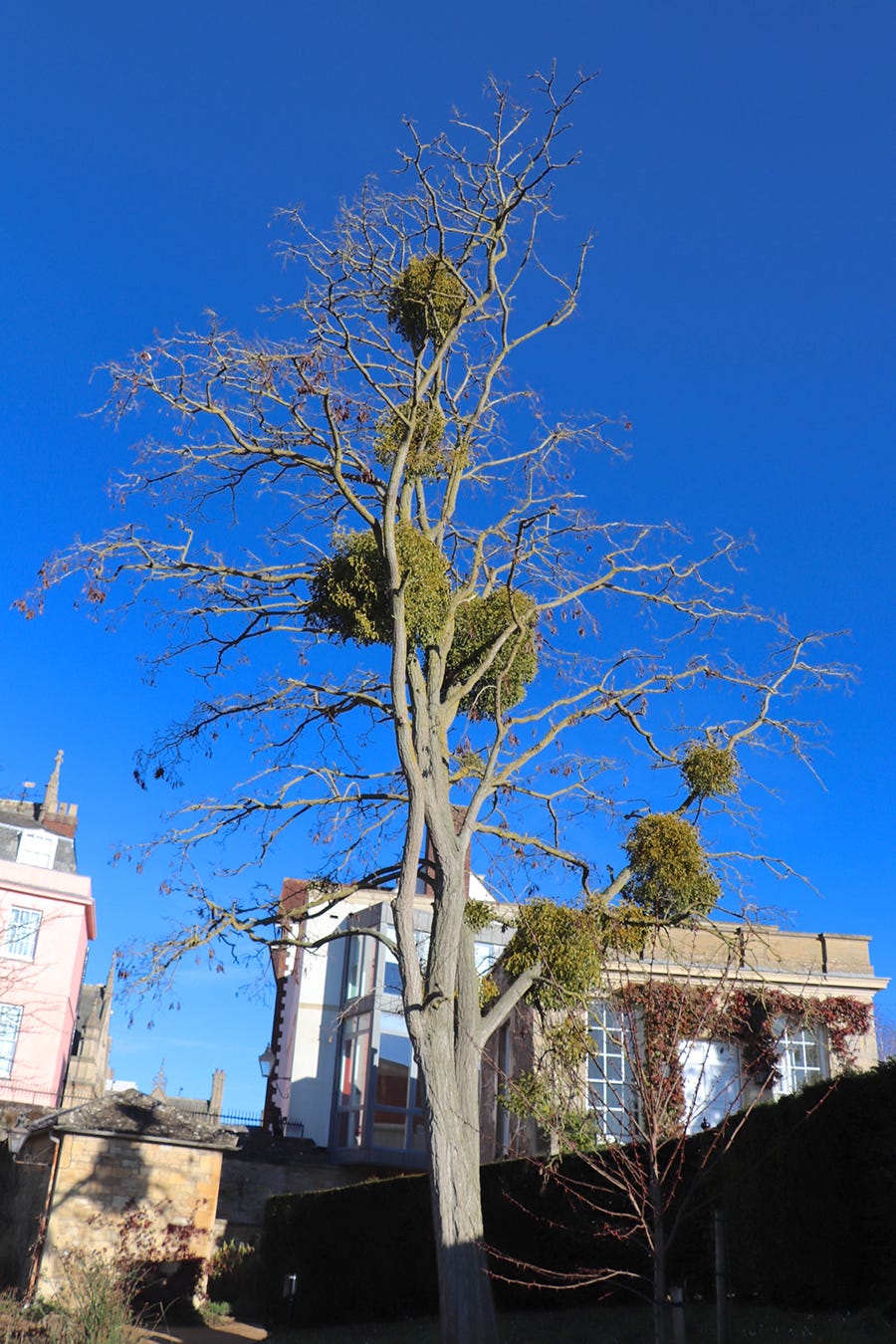Mistletoe: Tracking the festive flora that divides opinion
Play your part informing important research with MistleGO!...
The Tree Council and Fera Science are supporting University of Oxford DPhil candidate, Ollie Spacey with his research into mistletoe - a parasitic plant with strong ecological, socio-economic, and cultural importance to the UK.

It is the time of year when mistletoe is most easily seen in our trees, taking its place with holly as one of our most festive flora.
Despite the yuletide associations, mistletoe divides public opinion more than most other native UK plants. Speaking about my research with people from across the country at Oxford Botanic Garden’s Christmas Fair, I heard a diversity of views on this species. To some, mistletoe is an iconic and intriguing winter plant, with connotations of love, magic and festive tradition. To others, it is a pest, overwhelming the trees it grows on and getting out of control, especially in orchards where it requires regular management.
Whatever your view, however, you cannot deny that mistletoe is an important component of our ecosystems, and any changes in its abundance in the UK are of great interest.
While the history and culture surrounding mistletoe is fascinating, from Norse myths to druidic rituals to kissing traditions, I would argue that its biology is even more captivating.
Mistletoe is a parasitic plant, requiring a host tree from which it steals water and nutrients to survive and grow. Strictly, its ability to produce its own sugar via photosynthesis makes it a “hemiparasite”. The only mistletoe in the UK is European mistletoe (Viscum album), a native plant which can grow on over 400 tree taxa. Mistletoe can grow extensively on its favourite hosts (apple, poplar and Tilia) leading to decreased tree growth, and sometimes contributing to tree death.

Nonetheless, mistletoe is often benign in small amounts. Plus, the provision of food for winter birds which spread its seed, housing of several endemic invertebrates found only on mistletoe, and facilitation of nutrient cycling through leaf litter make mistletoe a friend of other species in the ecosystem. Indeed, the double-edged ecological impacts of mistletoes seem to aptly mirror the views of the public.
Despite being a staple part of our native flora, mistletoe distribution appears to be changing. National-level surveys ran by the BSBI in 1970s (Perring, 1973) and 1990s (the latter with Plantlife) (Briggs, 1999) suggested that mistletoe was present across much of England and Wales, with some rarer observations in Scotland. Concentrated along the southern Welsh border and in the south-west English midlands, mistletoe distribution seems to depend on factors including climate and host tree availability.
With a changing climate and shifting treescape, mistletoe is expected to be on the move northward, and spreading extensively in local hotspots. Quantifying this change is difficult, however. Like many parasites, potential for transmission depends on local abundance, yet data on local mistletoe density has never been collected at a national scale (only even presence/absence records). Also, data on host tree ID was poor in previous surveys, and the role of bird vectors which spread the mistletoe neglected. We need a new and improved survey to understand the future of UK mistletoe.
Enter MistleGO!, an app-based national-level mistletoe abundance survey developed and operated by me at the University of Oxford, and colleagues in the Science & Research team at The Tree Council.

Recorders are encouraged to submit observations of mistletoe they see via the MistleGO! survey which they can install onto the Survey123 app on their smartphones. Quite simply, when you identify one or more trees with some mistletoe, open the app and the location will be automatically recorded. Then, take a photo of the tree (or trees) and record roughly how many clumps you can see (e.g., 1, 2-5, 6-10, etc). The final part of the survey is to record the habitat the mistletoe is found in. Knowing whether the mistletoe is growing in an orchard, park or garden will be crucial to predicting where mistletoe will end up in the future. The recorder can add in extra info such as host ID (which we appreciate is difficult in winter) if they wish, and otherwise, submit!
The records collected will allow us to map the UK’s mistletoe today, and then try and predict where it is likely to end up in future, what the implications might be, and where management may be helpful. Also, combined with data on bird distributions, the role of mistle thrushes, blackcaps and other seed dispersers in spreading future mistletoe can be quantified.
Love it or hate it, by understanding the present and future of mistletoe in the UK, we can attempt to balance the ecological good and bad this festive parasite brings to our landscape.
Ollie Spacey is a DPhil candidate at the University of Oxford
To find out more, please visit: www.treecouncil.org.uk/science-and-research/mistletoe-research/. You can download the MistleGO! app by visiting https://arcg.is/1vnbru0. The survey is run through ArcGIS Survey 123. MistleGO! is supported and funded by NERC, University of Oxford, The Tree Council and FERA Science



